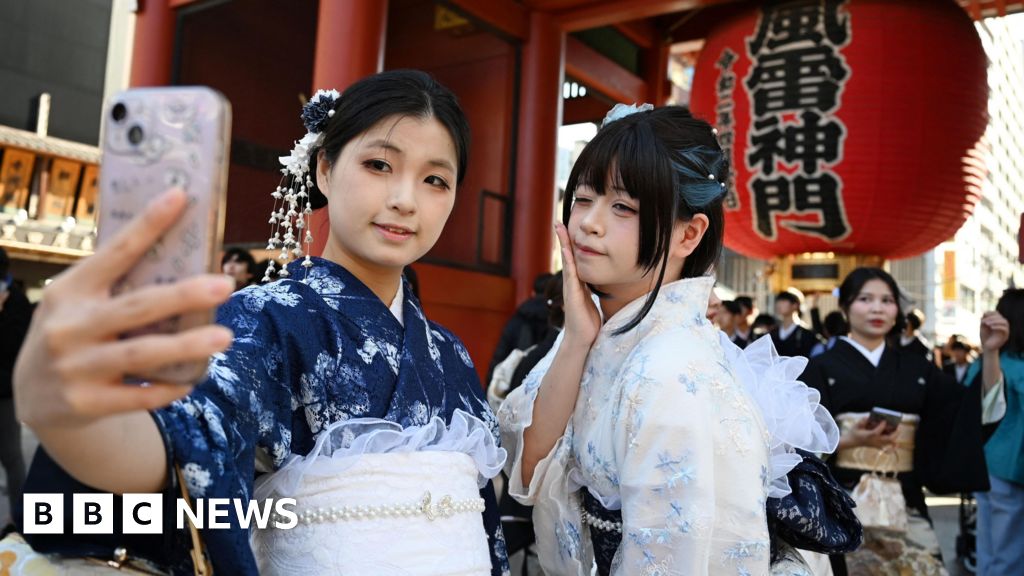Business
Japan tourism and retail stocks slide after China row

Japanese tourism and retail stocks fell on Monday after China warned its citizens not to travel to the country as Tokyo and Beijing remain locked in a row over Taiwan.
Japan’s Prime Minister Sanae Takaichi, who has been a vocal critic of China and its military activities in the region, suggested this month Tokyo could take military action if Beijing attacked Taiwan.
Shares in cosmetics company Shiseido plunged nearly 10% while department store chain Takashimaya and the owner of global fashion chain Uniqlo fell more than 5% in early trading.
China has consistently ranked among the top sources of tourists visiting Japan.
The share price falls came after the dispute between Beijing and Tokyo has deepened in recent days.
On Sunday, the Chinese government urged its citizens to reconsider studying in Japan, citing risks to their safety and a rise in crimes targeting Chinese people.
China’s Education Ministry also told students already based in Japan to closely monitor the security situation.
Last year, more than 100,000 Chinese students were enrolled in educational institutions in Japan, according to a Japanese government survey.
Also over the weekend, Chinese airlines – including China Southern Airlines, China Eastern Airlines, and Air China – offered refunds for flights to Japan.
Takaichi said in the Japanese parliament on 7 November: “If there are battleships and the use of force, no matter how you think about it, it could constitute a survival-threatening situation.”
A “survival-threatening situation” is a legal term under Japan’s 2015 security law, referring to when an armed attack on its allies presents an existential threat to Tokyo.
In such a situation, Japan’s self-defence forces can be called upon to respond to the threat.
Taiwan lies around 100km (60 miles) south of the closest Japanese island.
Beijing sees Taiwan as a breakaway province that will, eventually, be part of the country, and has not ruled out the use of force to achieve this.
But many Taiwanese consider themselves to be part of a separate nation – although most are in favour of maintaining the status quo where Taiwan neither declares independence from China nor unites with it.
Business
How my on-air ‘brain fog’ moment sparked a big debate

Zoe KleinmanTechnology editor
 BBC
BBCWhen I rather nervously shared a personal post about dealing with brain fog at work on the social network LinkedIn last week, I had no idea that it would have such an enormous impact.
It’s been viewed hundreds of thousands of times. Women have stopped me on the street to talk to me about it.
I’ve been overwhelmed by hundreds of messages from people sharing support and their own experiences of it.
Usually I cover technology news. But given the response, it felt important to talk about this as well.
“Brain fog” isn’t a medical term. But you may well know exactly what I’m talking about.
That moment when you suddenly can’t remember the word for something really obvious, or you’re mid-sentence and you lose your train of thought. It’s infuriating, and it can be embarrassing.
Where was I?
Ah yes, for me, as a woman in my 40s, it’s coincided with perimenopause – the stage in my life where my hormone levels are changing. There can of course be other neurological conditions for which brain fog can be a symptom too.
If you’re in a job where public speaking is part of what you do, it can be particularly terrifying.
“I’ve spent 30 years being professionally articulate,” wrote Janet Edgecombe, an internal communications expert.
“All of a sudden I’m forgetting the words for basic things. ‘That grey thing in the thingy that we cook chicken on’. My husband replies ‘oh, the baking tray in the oven’. Hmm. ‘Yeah, that thing’.”
 Getty Images
Getty ImagesI also heard from teachers, start-up founders having to present pitches for money to investors, women running workshops, delivering speeches – and fellow journalists trying to report live on-air, like me. But of course it can also hit mid-conversation, in a more intimate but no less frustrating way.
My post was about my decision to hold a page of notes on the BBC News at Ten. A story had broken late in the afternoon, following an already busy day, and by the time we reached 10pm, I knew I was getting tired and I could feel the brain fog.
I was going to talk about an outage that was affecting dozens of websites and apps, and I planned to use the technical jargon for it, as given by the company affected, and then explain what it actually meant.
But I just couldn’t get the phrase to stick in my head and I knew that without it, I wouldn’t manage the rest of what I needed to say.
I was reporting live from Glasgow. Like many of my professional peers, I do not have, and I’ve never had, autocue. And so, for the first time, I decided at the last minute to hold a page of notes with the offending phrase on it.
It felt to me at the time like an admission of failure. I have been trained never to use notes – unless there’s a specific legal reason why the wording of a statement, for example, has to be precise, or there are a lot of figures to remember.
Even then, I have prided myself on having a good enough short-term memory to get me through.
Using notes is discouraged in the world of public speaking. They are not permitted to anyone giving a 12-minute TED talk. The speaker is expected to memorise their speech.
Looking down the barrel of the camera and clutching that paper, live on TV, felt tough.
But around 10% of women report leaving their jobs due to menopause symptoms, according to the Fawcett Society. And research by insurance firm Royal London found that half of women going through it have considered giving up work. I don’t want to do that – and so I stuck with my solution.
To my intense relief, some people said they thought my paper looked authoritative, that they just assumed it was a breaking story and the page contained fresh information. Others asked why I hadn’t used a device instead – I suppose I thought the potential of having to fumble with a screen would feel even worse.
“Let’s start a movement: Hold your notes,” wrote Elisheva Marcus, vice president of communications at the venture capitalist firm Earlybird.
And so, the hashtag holdthenotes was born.
“Have you ever checked your testosterone levels?” menopause expert Dr Louise Newson asked me.
She says testosterone – despite its reputation for being a male hormone, and its association with sex drive and libido, is actually an essential brain chemical for both men and women, and levels fall in both genders. One of the results is brain fog.
“It’s like you’ve been drugged,” she says. “It’s really scary, a lot of people worry they’ve got dementia.”
“I remember when I had my levels done 10 years ago, and I was like ‘Thank God, at least I know why I’m feeling so awful’.”
She adds that there are studies dating back to the 1940s indicating that testosterone can improve brain function and wellbeing in women as well as men, but the randomised control studies, where participants are given either a placebo or the product itself in order to see whether it really works, have only focused on improvements to libido.
NHS-prescribed Hormone Replacement Therapy, or HRT, is traditionally a combination of oestrogen and progesterone. Testosterone is not routinely included.
Instead doctors can separately prescribe testosterone to female patients, at lower doses than given to men.
 Getty Images
Getty ImagesThere are also a myriad of menopause supplements which claim to ease symptoms including brain fog. Estimates vary but it’s a multi-billion dollar industry and its booming.
Women spend an average of £147 per year on supplements to try to alleviate their menopause symptoms, according to a survey earlier this year by the nutrition news website NutraIngredients.
“They might help a bit,” says Dr Newson.
“I do yoga every day, and that helps my brain become clear and focused, but I have a hormone deficiency, I can’t eat my way out of it, or exercise my way out of it.
“A lot of women spend a fortune trying to improve symptoms of a hormone deficiency with something else.”
Dr Joshua Chen is part of the Harvard Medical School-Massachusetts General Hospital Photobiomodulation Research Group. The team is looking at how frequencies of red light can change the mitochondria inside the brain to improve focus.
He describes it as “like a face mask, but for the brain”. It can also, he says, be applied to the Vagus nerve on the neck to reduce stress.
He has founded a company called Niraxx which markets a headband called a neuro espresso, which is designed to be worn for up to 20 minutes a day. He claims the results are instant. It has to be plugged in – there are no batteries in the device for safety reasons.
 Niraxx
NiraxxAngela Marsh is a registered nurse and a menopause coach. She says her clients often describe brain fog as feeling like they are “living life in soft focus”.
“I don’t think brain fog is taken seriously enough at all,” she says.
“Many women feel deeply unsettled by the changes they experience. They think there’s something wrong with them or they’re ‘losing it’ when in fact there’s a clear biological reason.”
As for me – well, I’ve booked a blood test to check my hormone levels. I’m going to try some red-light therapy. And you are probably going to see me holding notes a bit more often.
Business
Guardrails in place for AI-led commerce: Visa – The Times of India

SINGAPORE: Payments giant Visa is looking to launch agentic commerce pilots across the Asia-Pacific region as regulatory and ecosystem readiness advances by early next year. Agentic commerce refers to a new era where AI-powered agents shop and pay on behalf of users. The company’s Visa Intelligent Commerce (VIC) programme incorporates features like tokenisation, authentication, payment instructions, and transaction signals. As far as India is concerned, VIC will be launched once regulatory approvals are in place. “If you take the combination of tokenisation and RBI’s new authentication circular, the enabling regulatory environment is right for agentic commerce. We will have discussions. I want to have my team go and demo it to RBI, and we want to make sure we do it in a responsible manner with all the due regulatory approvals in place,” Visa’s head of products and solutions (Asia-Pacific) T R Ramachandran said during the Singapore Fintech Festival here last week.“The pace of e-commerce and quick commerce, year-on-year growth in India has been staggering. The growth is no longer restricted to cities like Mumbai, Gurgaon, Kolkata, Chennai and Hyderabad. Amazon tells us that they have 6,000 pin codes from which they get shopping orders, which is huge. The rapid growth of LLMs (large language models) will only accelerate online shopping. As far as agentic commerce is concerned, we are not letting somebody run amok without guardrails or without controls or without constraints,” he said.When it comes to detecting fraud, Ramachandran said that Visa has been securing the ecosystem with AI-driven risk services for banks and fintechs in India. It has implemented AI-led ‘visa advanced authorisation’ and ‘visa risk manager’ across most banking partners and fintechs, strengthening real-time fraud detection and ecosystem resilience.(The writer was in Singapore at the invitation of Visa)
Business
When will Americans receive $2,000 tariff dividends? Donald Trump speaks out – The Times of India

President Donald Trump has said Americans could see $2,000 tariff dividend checks in 2026, but no exact date has been set yet, although he hinted at the timeline.The payments are expected to come from revenue raised through tariffs.Speaking to reporters aboard Air Force One on Friday, Trump said the checks will not arrive in time for the Christmas shopping season. “It will be next year. The tariffs allow us to give a dividend. We’re going to do a dividend and we’re also going to be reducing debt,” he said.The MAGA chief first floated the idea of tariff dividends earlier this month, suggesting that high-income earners would be excluded, though he did not define a specific income threshold. Trump said his Truth Social platform, “A dividend of at $2000 a person (not including high income people!) will be paid to everyone. Those against the tariffs are FOOLS!”
Rebate for families making less than $100,000
Treasury Secretary Scott Bessent explained last week that the administration was still discussing income limits. “Well, there are a lot of options here that the president’s talking about a $2,000 rebate and those — that would be for families making less than, say, $100,000,” Bessent told Fox & Friends, later clarifying that no final decision had been made.The plan faces legal hurdles. The US Supreme Court has questioned the legality of Trump’s tariffs under the International Emergency Economic Powers Act, raising the possibility that some could be struck down. Trump acknowledged that if the Court rejects the tariffs, “Then I’d have to do something else.” The payments would also require congressional approval, with some Republicans sceptical and urging a focus on reducing the federal deficit.Trump’s tariffs, including IEEPA tariffs, have raised around $90 billion since implementation, with all tariffs taking in $195.9 billion in fiscal 2025. Analysts estimate that if the $2,000 dividend were limited to individuals earning under $100,000, the cost would be about $300 billion, according to the New York Post. Trump has repeatedly argued that tariffs are a tool to rebalance trade and support American businesses. Treasury Secretary Bessent said the tariffs are intended to create a “perfect storm” for rebalancing trade rather than merely raising revenue.The GOP leader remains committed to the idea of sending checks to Americans. “We are taking in Trillions of Dollars and will soon begin paying down our ENORMOUS DEBT, $37 Trillion. Record Investment in the USA, plants and factories going up all over the place,” he posted on Truth Social.
-

 Entertainment1 week ago
Entertainment1 week agoChina unveils£5.4 bn Fujian, its most advanced aircraft carrier yet
-

 Tech6 days ago
Tech6 days agoFrom waste to asset: Turning ethanol production CO₂ into jet fuel
-

 Politics1 week ago
Politics1 week agoIDF lawyers warned of possible Gaza war crimes: US intel findings
-

 Tech2 days ago
Tech2 days agoNew carbon capture method uses water and pressure to remove CO₂ from emissions at half current costs
-

 Sports1 day ago
Sports1 day agoTexas A&M officer scolds South Carolina wide receiver after touchdown; department speaks out
-
Sports1 week ago
College football winners and losers: The catch of the year saves Indiana
-

 Politics3 days ago
Politics3 days agoBritish-Pakistani honoured for transforming UK halal meat industry
-

 Business1 week ago
Business1 week agoMore than 1,000 flights cancelled as US air traffic cuts enter second day







